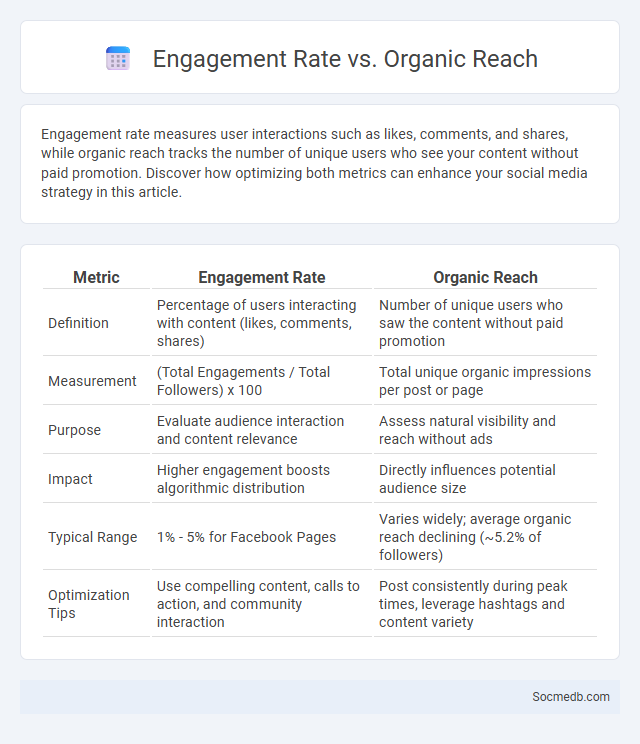
Photo illustration: Engagement Rate vs Organic Reach
Engagement rate measures user interactions such as likes, comments, and shares, while organic reach tracks the number of unique users who see your content without paid promotion. Discover how optimizing both metrics can enhance your social media strategy in this article.
Table of Comparison
| Metric | Engagement Rate | Organic Reach |
|---|---|---|
| Definition | Percentage of users interacting with content (likes, comments, shares) | Number of unique users who saw the content without paid promotion |
| Measurement | (Total Engagements / Total Followers) x 100 | Total unique organic impressions per post or page |
| Purpose | Evaluate audience interaction and content relevance | Assess natural visibility and reach without ads |
| Impact | Higher engagement boosts algorithmic distribution | Directly influences potential audience size |
| Typical Range | 1% - 5% for Facebook Pages | Varies widely; average organic reach declining (~5.2% of followers) |
| Optimization Tips | Use compelling content, calls to action, and community interaction | Post consistently during peak times, leverage hashtags and content variety |
Understanding Engagement Rate
Engagement rate measures the level of interaction a social media post receives relative to its audience size, typically calculated by dividing total engagements (likes, comments, shares) by the number of followers and multiplying by 100. A high engagement rate indicates strong content resonance and audience connection, which boosts organic reach and algorithm favorability on platforms like Instagram, Facebook, and Twitter. Tracking engagement rate helps brands optimize posting strategies, tailor content to audience preferences, and improve overall social media performance metrics.
Defining Organic Reach
Organic reach on social media refers to the number of unique users who see a brand's content without paid promotion. It is influenced by factors such as platform algorithms, user engagement, and content relevance. Maximizing organic reach requires creating valuable, shareable content that resonates with the target audience.
Engagement Rate vs Organic Reach: Key Differences
Engagement rate measures how actively your audience interacts with your content through likes, comments, shares, and clicks, providing insights into content effectiveness and audience involvement. Organic reach refers to the total number of unique users who see your posts without paid promotion, reflecting the visibility your content gains naturally. Understanding the balance between your engagement rate and organic reach helps optimize social media strategies to boost authentic interactions and expand your audience reach.
Why Engagement Rate Matters
Engagement rate measures how actively your audience interacts with your social media content, reflecting the quality and relevance of your posts. Higher engagement rates indicate a loyal and interested following, which can boost your brand visibility and credibility. You should monitor this key metric to optimize your social media strategy and foster meaningful connections with your audience.
The Impact of Organic Reach on Social Media Metrics
Organic reach significantly influences social media metrics by determining the number of users who naturally encounter your content without paid promotion. High organic reach improves engagement rates, boosts brand credibility, and enhances audience trust, which in turn drives sustained growth. Optimizing your content strategy for organic reach ensures Your brand achieves authentic visibility and meaningful interactions across social media platforms.
Measuring Engagement Rate Effectively
Measuring engagement rate effectively involves tracking key metrics such as likes, comments, shares, and click-through rates to assess audience interaction accurately. Utilizing tools like Google Analytics, Sprout Social, or Hootsuite helps gather comprehensive data on user behavior and content performance. By calculating engagement rate as total interactions divided by total followers, brands can optimize social media strategies and improve content relevance.
Strategies to Boost Organic Reach
Implementing consistent content schedules and utilizing trending hashtags significantly enhance organic reach on social media platforms. Engaging audiences through interactive posts, such as polls and live videos, fosters higher user interaction and algorithmic preference. Leveraging user-generated content and collaborating with micro-influencers further amplifies visibility and authenticity, driving sustainable organic growth.
Balancing Engagement Rate and Organic Reach
Balancing engagement rate and organic reach on social media requires optimizing content that resonates with your target audience while adhering to platform algorithms that prioritize meaningful interactions. Leveraging user-generated content, timely posting, and interactive features like polls or stories can enhance both metrics. Prioritizing quality engagement over quantity ensures Your social media presence grows authentically and sustainably.
Tools to Analyze Engagement Rate and Organic Reach
Effective tools to analyze engagement rate and organic reach include platforms like Sprout Social, Hootsuite Insights, and Buffer Analyze, which provide in-depth metrics on likes, shares, comments, and follower growth. Your ability to interpret data from native analytics on Facebook Insights, Instagram Insights, and Twitter Analytics helps optimize content strategies and maximize audience interaction. Utilizing these tools allows you to track organic reach trends and engagement performance, enabling data-driven decisions to enhance social media marketing efforts.
Choosing the Right Metric for Your Social Media Goals
Selecting the right metric is crucial for measuring the success of your social media strategy, as it directly aligns with your specific goals, whether those are brand awareness, engagement, or conversion rates. Key performance indicators (KPIs) such as reach, click-through rates, or follower growth provide valuable insights tailored to your objectives. Optimizing your focus on these metrics ensures your campaigns deliver measurable results that enhance your overall social media effectiveness.
 socmedb.com
socmedb.com